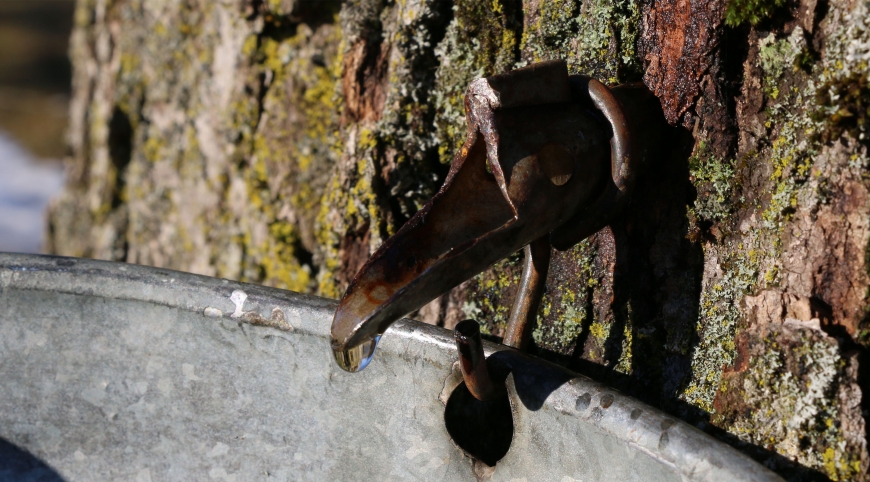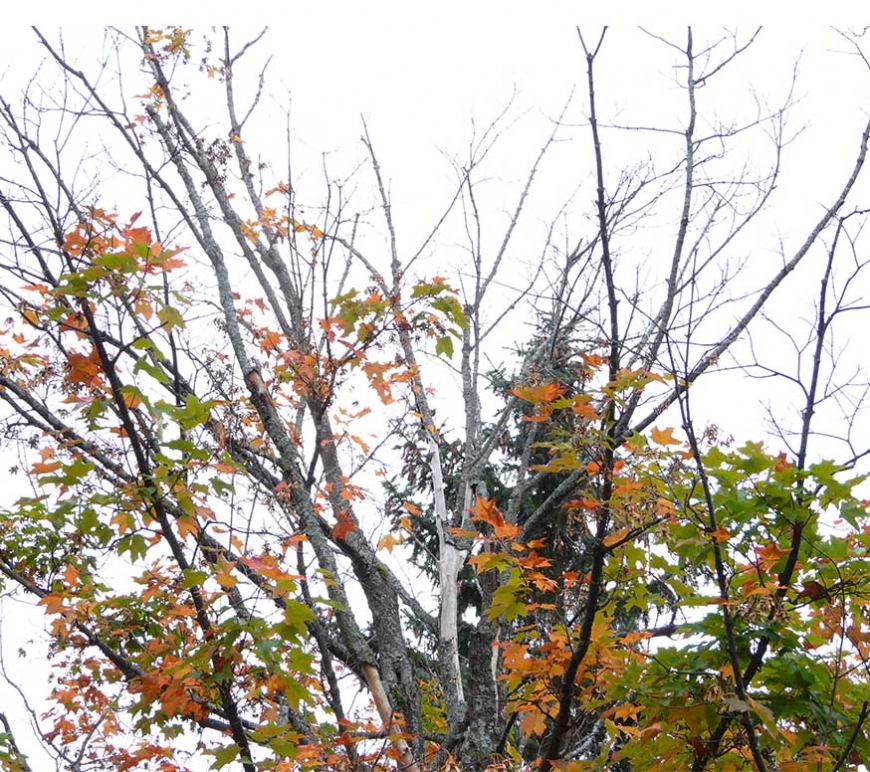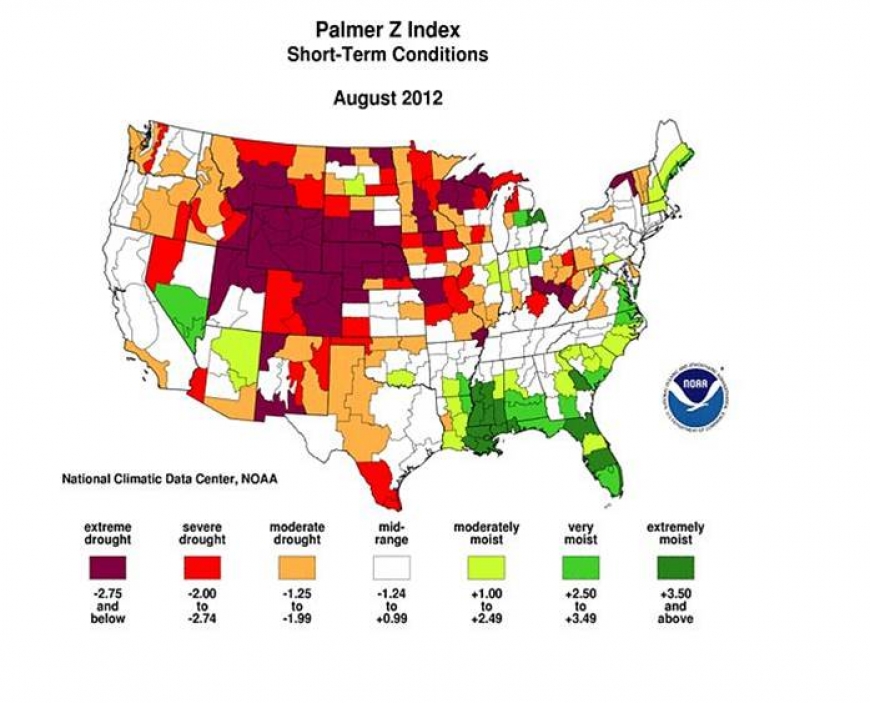


The maple sugaring industry, and the traditions that surround it, rest of the fate of sugar maples.
Branch dieback is a common symptom of maple decline.
Maples are just recovering from the 2012 summer drought, which caused record-low soil moisture in the North Country.



What Causes Maple Decline?
As the 2016 maple sugaring comes to a close, many Northern New York maple producers are calling it a good year. The sap ran early – some local producers report boiling their first batch in late January – and kicked up again in March and early April, leading to solid yields across the region. But even as we celebrate a successful maple season, recent research calls into question the vitality of sugar maple trees in the North Country.
Last fall, researchers from SUNY ESF published results of a study in the journal Ecosphere from an analysis of sugar maple growth rings from 18 sites across the Adirondacks. They found that the growth rates of Adirondack sugar maples have been in decline for the past several decades, despite a trend towards warmer, wetter conditions that should favor tree growth. Daniel Bishop, lead author of the study, told ESF Communications “Given their relatively young age and favorable competitive status in these forests, these sugar maples should be experiencing the best growth rates of their lives. It was a complete surprise to see their growth slow down like this, but our data tells a clear story. We can detect the start of a region-wide downturn after 1970, with a large proportion of the trees continuing this trend over recent years."
 Slow growth is a common indicator of declining tree health, and the effects could be far reaching. In addition to the cultural and economic importance of maple sugaring, sugar maples are renowned for their quality timber and vibrant fall colors. They are also considered to be a keystone species in northern hardwood forest – white-tailed deer and moose browse sugar maple leaves, numerous rodents consume their seeds, and songbirds, woodpeckers, and owls nest in their branches and trunks. With their nitrogen-rich leaf litter, sugar maples also play an important role in regulating the availability of nutrients in forest soil. In St. Lawrence County, more than half of our forests are co-dominated by maple, beech, and birch trees. With mature beech trees dealing with health problems of their own, I shudder to imagine a landscape where sugar maples are suffering as well.
Slow growth is a common indicator of declining tree health, and the effects could be far reaching. In addition to the cultural and economic importance of maple sugaring, sugar maples are renowned for their quality timber and vibrant fall colors. They are also considered to be a keystone species in northern hardwood forest – white-tailed deer and moose browse sugar maple leaves, numerous rodents consume their seeds, and songbirds, woodpeckers, and owls nest in their branches and trunks. With their nitrogen-rich leaf litter, sugar maples also play an important role in regulating the availability of nutrients in forest soil. In St. Lawrence County, more than half of our forests are co-dominated by maple, beech, and birch trees. With mature beech trees dealing with health problems of their own, I shudder to imagine a landscape where sugar maples are suffering as well.
Threats to maple health are nothing new. Forest researchers use the term maple decline to describe a range of symptoms including branch dieback, leaf discoloration, and sparse foliage growth that indicate poor vigor in maple trees. Maple decline has been observed in sugar maple populations across its native range for decades, but it appears to be becoming increasingly common. Fortunately, sugar maples have largely proved resilient, and in fact there are actually more large sugar maples in the Eastern US today than there were three decades ago, according to US Forest Service data. But consider this: a 50 year-old sugar maple tree in St. Lawrence County has already weathered the 1998 ice storm, the 2012 drought, decades of acid rain, and at least one outbreak of tent caterpillars or other tree pests. Most often it’s not a single factor, but an accumulation of stressors that result in maple decline.
Inevitably, any discussion of the sugar maple health and the sustainability of the maple industry must address climate change. Mike Farrell, director of Cornell’s Uihlein Sugar Maple Research Station in Lake Placid and author of The Sugarmaker’s Companion, divides the implications of climate change into two distinct categories: how climate will impact the maple industry, and what it means for tree health and distributions. Research conducted by Cornell University suggests that the start date for tapping maples is already a week earlier than it was in 1970, and the first sap flow dates will be a full month earlier by 2100. While this sounds dramatic, Northern New York maple producers shouldn’t panic – as long as they’re willing to adapt. Farrell suggests that sugarmakers in the North Country should plan on tapping earlier, and using vacuum systems to keep sap flowing from the tree when winter temperatures remain above freezing for an extended period of time.

How climate change will impact sugar maple health and distribution is more vexing. The geographic range of sugar maples, which extends from northern Georgia through Quebec, suggests that they can adapt to a wide range of climatic conditions. Models predict that climate change will result in warmer temperatures that could cause heat stress in sugar maples. Even more concerning are the potential impacts of extreme weather events, such as droughts and ice storms, that are predicted to become more frequent due to climate change. The 1998 ice storm caused severe damage to 26% of maples in Northern New York sugarbushes. It can take a sugar maple 2-3 years to recover from an extreme drought, such as the one we experienced in 2012, and during this time it will be more susceptible to fungal pathogens and insect pests.
But will climate change threaten the existence of sugar maples in the Northeast? Farrell argues that if we ever reach the point when the climate in our region is no longer suitable for sugar maple growth, “we will have much bigger problems to contend with than a lack of pure maple syrup.”
Here in the North Country, the fate of sugar maples could impact everything from the biodiversity in our forests, to the crowds of leaf peeping fall tourists, to our breakfast rituals, to the livelihoods of our neighbors. Maple decline is a complex problem that stubbornly resists a simple explanation. It’s tempting to want find a single culprit, when in reality a complex interaction of climatic factors, soil characteristics, insect outbreaks, and tree pathogens determines tree health. So let’s enjoy what we have in the present – a bumper crop of fresh maple syrup – and stay vigilant for signs of stress in our local sugar maples in the future.
A great way to do so is to get involved in our Monitor My Maple citizen science project. Pick a sugar maple near you, keep track of its seasonal changes throughout the year, and share your observations with us. Your data will contribute to our understanding of sugar maple health in the North Country.

